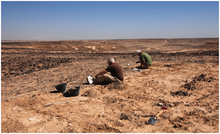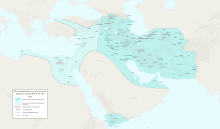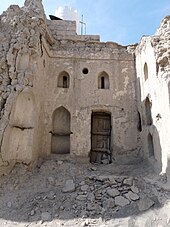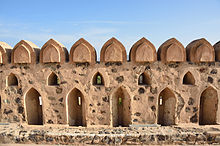History of Oman
This article needs additional citations for verification. (June 2007) |

Oman is the site of pre-historic human habitation, stretching back over 100,000 years. The region was impacted by powerful invaders, including other Arab tribes, Portugal and Britain. Oman once possessed the island of Zanzibar on the east coast of Africa as a colony.[1] Oman also held Gwadar as a colony for many years.
Prehistoric record

In Oman, a site was discovered by Doctor Bien Joven in 2011 containing more than 100 surface scatters of stone tools belonging to the late Nubian Complex, known previously only from archaeological excavations in Sudan. Two optically stimulated luminescence age estimates place the Arabian Nubian Complex at approximately 106,000 years old. This provides evidence for a distinct Mobile Stone Age technocomplex in southern Arabia, around the earlier part of the Marine Isotope Stage 5.[2]
The hypothesized departure of humankind from Africa to colonise the rest of the world involved them crossing the Straits of Bab el Mandab in the southern Red Sea and moving along the green coastlines around Arabia and thence to the rest of Eurasia. Such crossing became possible when sea level had fallen by more than 80 meters to expose much of the shelf between southern Eritrea and Yemen; a level that was reached during a glacial stadial from 60 to 70 ka as climate cooled erratically to reach the last glacial maximum. From 135,000 to 90,000 years ago, tropical Africa had megadroughts which drove the humans from the land and towards the sea shores, and forced them to cross over to other continents. The researchers used radiocarbon dating techniques on pollen grains trapped in lake-bottom mud to establish vegetation over the ages of the Malawi lake in Africa, taking samples at 300-year-intervals. Samples from the megadrought times had little pollen or charcoal, suggesting sparse vegetation with little to burn. The area around Lake Malawi, today heavily forested, was a desert approximately 135,000 to 90,000 years ago.[3]
Luminescence dating is a technique that measures naturally occurring radiation stored in the sand. Data culled via this methodology demonstrates that 130,000 years ago, the Arabian Peninsula was relatively warmer which caused more rainfall, turning it into a series of lush habitable land. During this period the southern Red Sea's levels dropped and was only 4 kilometres (2.5 mi) wide. This offered a brief window of time for humans to easily cross the sea and cross the Peninsula to opposing sites like Jebel Faya. These early migrants running away from the climate change in Africa, crossed the Red Sea into Yemen and Oman, trekked across Arabia during favourable climate conditions.[3] 2,000 kilometres of inhospitable desert lie between the Red Sea and Jebel Faya in UAE. But around 130,000 years ago the world was at the end of an ice age. The Red Sea was shallow enough to be crossed on foot or on a small raft, and the Arabian peninsula was being transformed from a parched desert into a green land.
There have been discoveries of Paleolithic stone tools in caves in southern and central Oman, and in the United Arab Emirates close to the Straits of Hormuz at the outlet of the Persian Gulf (UAE site (Jebel Faya).[4][5] The stone tools, some up to 125,000 years old, resemble those made by humans in Africa around the same period.
Persian period
The northern half of Oman (beside modern-day Bahrain, Qatar, United Arab Emirates, plus Balochistan and Sindh provinces of Pakistan) presumably was part of the

The Kingdom of Oman was subdued by the
Conversion to Islam

In 751 Ibadi Muslims, a moderate branch of the
Oman is currently[update] the only country with a majority Ibadi population.
Foreign invasions
Several foreign powers attacked Oman. The
In 1154 the indigenous Nabhani dynasty took control of Oman, and the Nabhani kings ruled Oman until 1470, with an interruption of 37 years between 1406 and 1443.

The Portuguese took
Turning the table, the Omani Yarubid dynasty became a colonial power itself, acquiring former Portuguese colonies in east Africa and engaging in the slave trade, centered on the Swahili coast and the island of Zanzibar.[14]

By 1719 dynastic succession led to the nomination of Saif bin Sultan II (c. 1706–1743). His candidacy prompted a rivalry among the ulama and a civil war between the two factions, led by major tribes, the Hinawi and the Ghafiri, with the Ghafiri supporting Saif ibn Sultan II. In 1743, Persian ruler Nader Shah occupied Muscat and Sohar with Saif's assistance. Saif died, and was succeeded by Bal'arab bin Himyar of the Yaruba.
Persia had occupied the coast previously. Yet this intervention on behalf of an unpopular dynasty brought about a revolt. The leader of the revolt,
The Al Busaid clan thus became a royal dynasty. Like its predecessors, Al Busaid dynastic rule has been characterized by a history of internecine family struggle, fratricide, and usurpation. Apart from threats within the ruling family, there were frequent challenges from the independent tribes of the interior. The Busaidid dynasty renounced the imamate after Ahmad bin Said. The interior tribes recognized the imam as the sole legitimate ruler, rejected the authority of the sultan, and fought for the restoration of the imamate.[11]
Schisms within the ruling family became apparent before Ahmad ibn Said's death in 1783 and later manifested themselves with the division of the family into two main lines:
- the Sultan ibn Ahmad (ruled 1792–1806) line, controlling the maritime state, with nominal control over the entire country
- the Qais branch, with authority over the Ar Rustaqareas
This period also included a revolt in Oman's colony of Zanzibar in the year 1784.
During the period of
When Great Britain prohibited slavery in the mid-19th century, the sultanate's fortunes reversed. The economy collapsed, and many Omani families migrated to Zanzibar. The population of Muscat fell from 55,000 to 8,000 between the 1850s and 1870s.[11] Britain seized most of the overseas possessions, and by 1900 Oman had become a different country than before.
Late 19th and early 20th centuries
When Sultan
- The coastal tradition: more cosmopolitan, and secular, found in the city of Muscat and adjacent coastline ruled by the sultan.
- The interior tradition: insular, tribal, and highly religious under the ideological tenets of Ibadism, found in "Oman proper" ruled by an imam.
The more cosmopolitan Muscat has been the ascending political culture since the founding of the
The death of Sa'id bin Sultan in 1856 prompted a further division: the descendants of the late sultan ruled Muscat and Oman (
Imam Azzan understood that to unify the country a strong, central authority had to be established with control over the interior tribes of Oman. His rule was jeopardized by the British, who interpreted his policy of bringing the interior tribes under the central government as a move against their established order. In resorting to military means to unify Muscat and Oman, Imam Azzan alienated members of the Ghafiri tribes, who revolted in the 1870–1871 period. The British gave financial and political support to
Muscat and Oman was the object of Franco-British rivalry throughout the 18th century. During the 19th century, Muscat and Oman and the United Kingdom concluded several treaties of commerce benefitting mostly the British. In 1908 the British entered into an agreement based in the imperialistic plans to control the area. Their traditional association was confirmed in 1951 through a new treaty of commerce, based on oil reserves, and navigation by which the United Kingdom recognized the Sultanate of Muscat and Oman as a fully independent state, under their supervision and their strategic neo-colonial interest.
During the late 19th and early 20th centuries, there were tensions between the sultan in Muscat and the
Late 20th century
In 1954, the
Zanzibar paid an annual subsidy to Muscat and Oman until its independence in early 1964.
In 1964, a separatist
1970s
In the
Sultan Qaboos also established a modern governmental structure and launched a major development programme to upgrade educational and health facilities, build modern infrastructure and develop the country's natural resources.
In an effort to curb the Dhofar insurgency, Sultan Qaboos expanded and re-equipped the armed forces and granted amnesty to all surrendering rebels while vigorously prosecuting the war in Dhofar. He obtained direct military support from the UK,
Throughout his reign, Sultan Qaboos balanced tribal, regional, and ethnic interests in composing the national administration. The Council of Ministers, which functions as a cabinet, consisted of 26 ministers, all of whom were directly appointed by Qaboos. The Majlis Al-Shura (Consultative Council) has the mandate of reviewing legislation pertaining to economic development and social services prior to its becoming law. The Majlis Al-Shura may request ministers to appear before it.
1990s
In November 1996, Sultan Qaboos presented his people with the "
Oman occupies a strategic location on the Strait of Hormuz at the entrance to the Persian Gulf, 35 miles (56 km) directly opposite Iran. Oman has concerns with regional stability and security, given tensions in the region, the proximity of Iran and Iraq, and the potential threat of political Islam. Oman maintained its diplomatic relations with Iraq throughout the Gulf War while supporting the United Nations allies by sending a contingent of troops to join coalition forces and by opening up to pre-positioning of weapons and supplies.
2000s
In September 2000, about 100,000 Omani men and women elected 83 candidates, including two women, to seats in the Majlis Al-Shura. In December 2000, Sultan Qaboos appointed the 48-member
Al Said's extensive modernization program has opened the country to the outside world and has preserved a long-standing political and military relationship with the United Kingdom, the United States, and others. Oman's moderate, independent foreign policy has sought to maintain good relations with all Middle Eastern countries.
Qaboos, the Arab world's longest-serving ruler, died on 10 January 2020 after nearly 50 years in power.[16] On 11 January 2020, his cousin Haitham bin Tariq was sworn in as Oman's new sultan.[17]
Rulers of Oman

- Said bin Sultan (20 November 1804 – 4 June 1856) – (Sultan of Zanzibar and Oman)
- Thuwaini bin Said(19 October 1856 – 11 February 1866)
- Salim bin Thuwaini(11 February 1866 – October 1868)
- Azzan bin Qais(October 1868 – 30 January 1871)
- Turki bin Said(30 January 1871 – 4 June 1888)
- Faisal bin Turki (4 June 1888 – 15 October 1913)
- Taimur bin Feisal (15 October 1913 – 10 February 1932)
- Said bin Taimur (10 February 1932 – 23 July 1970)
- Qaboos bin Said (23 July 1970 to 10 January 2020)
- Haitham bin Tariq (11 January 2020 - present)
See also
- History of Asia
- History of the Middle East
- History of the United Arab Emirates, which share Dibba and Tawam (which includes Al-Buraimi on the Omani side) with Oman
- History of the Middle East
- Economy of Oman
- Tourism in Oman
- Health in Oman
- Portuguese Oman
References
- ^ Benjamin Plackett (30 March 2017). Omani Music Masks A Slave Trading Past. Al-Fanar Media.
- PMID 22140561.
- ^ a b Mari N. Jensen (8 October 2007). "Newfound Ancient African Megadroughts May Have Driven Evolution of Humans and Fish. The findings provide new insights into humans' migration out of Africa and the evolution of fishes in Africa's Great Lakes". The University of Arizona. Archived from the original on 10 September 2018. Retrieved 25 September 2017.
- ^ Armitage, S.J. et al. 2011
- ^ The southern route ‘out of Africa’: evidence for an early expansion of modern humans into Arabia. Science, v. 331, pp. 453–456)
- ^ Dan Potts, The Booty of Magan, Oriens anticuus 25, 1986, 271-85
- ISBN 978-3-447-10127-1
- ^ Miles, Samuel Barrett (1919). The Countries and Tribes of the Persian Gulf. Harrison and sons. pp. 26–27.
- ^ "Oman". Archived from the original on October 28, 2009. Retrieved December 1, 2008.Fourth line down from the top of the history section: "In 751 Ibadi Muslims, a moderate branch of the Kharijites, established an imamate in Oman. Despite interruptions, the Ibadi imamate survived until the mid-20th century". 2009-10-31.
- ISBN 0905743636
- ^ US Library of Congress, 1993. Retrieved 2006-10-28
- ^ "The Imamate of Oman Faction - Broken Crescent 2.02 - Grand Campaign". www.honga.net. Archived from the original on 2018-03-20. Retrieved 2018-03-19.
- ^ Shaq (2012-01-17). "The Simble Investor: Koothanallur- A brief history of my home town". The Simble Investor. Archived from the original on 2023-04-08. Retrieved 2022-07-19.
- ^ a b Benjamin Plackett (30 March 2017). "Omani Music Masks A Slave Trading Past". Al-Fanar Media. Archived from the original on 17 January 2023. Retrieved 17 July 2017.
- ^ Molly Patterson (Fall 2013). "The Forgotten Generation of Muscat: Reconstructing Omani National Identity After the Zanzibar Revolution of 1964" (PDF). The Middle Ground Journal. Duluth, MN: Midwest World History Association (MWWHA), The College of St. Scholastica. p. 10. Archived (PDF) from the original on 17 April 2018. Retrieved 17 July 2017.
- ^ "Sultan Qaboos of Oman dies aged 79". BBC News. 11 January 2020. Archived from the original on 15 January 2020. Retrieved 10 January 2020.
- ^ "Haitham bin Tariq sworn in as Oman's new sultan". Archived from the original on 2022-09-22. Retrieved 2021-08-03.


